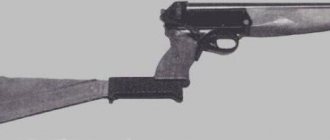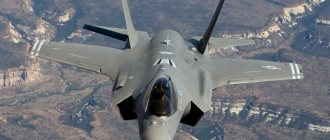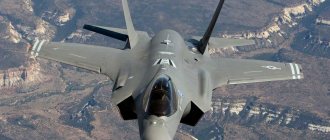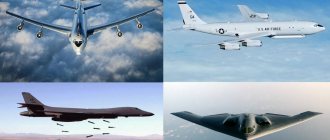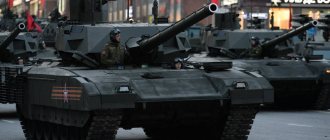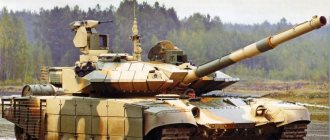Some time ago, UAC President Yuri Slyusar announced that the entire fleet of MiG-31 fighter-interceptors would be modernized by 2023.
“We expect that in the coming years the VKS will receive several dozen more modernized MiG-31BMs, so that by 2023 the entire existing fleet will be modernized,” Slyusar said.
Despite the fact that test pilot Alexander Fedotov made the first flight of the MiG-31 on September 16, 1975, even today this fighter remains one of the unique aircraft in the world. It is intended for use in the country's air defense system. It can carry out long-term patrols and fight at any time of the day in difficult weather conditions with intensive electronic warfare against all classes of aerodynamic targets (small cruise missiles, helicopters, high-altitude hypersonic aircraft, strategic bombers, low-orbit satellites and spacecraft, unmanned aerial vehicles).
How it all began?
Aerospace show in Le Bourget, 1991.
© Photo by Vladimir Yatsina (TASS Photo Chronicle)
The MiG-31 (NATO classification: Foxhound) was developed at OKB-155 (now RSK MiG) in the 1970s. It was the first Soviet fourth generation combat aircraft. At the initial phase, the work was led by chief designer Alexander Chumachenko. Then, at the stage of deep engineering development and testing, the legendary Gleb Lozino-Lozinsky. In 1975, after Gleb Evgenievich began developing the Buran, work on creating the aircraft was headed by Konstantin Vasilchenko.
The combat capabilities of the fighter were supposed to be significantly expanded through the use of the latest electronic equipment, in particular, a radar with a passive phased array antenna being used for the first time. The MiG-31 was built according to the design of the MiG-25 aircraft, but with a crew of two people - a pilot and a navigator-operator.
The MiG-31 prototype made its first flight on September 16, 1975. By decree of the USSR Council of Ministers of May 6, 1981, the MiG-31 fighter-interceptor with the RP-31 radar and R-33 missiles was put into service. Serial production began in 1979. By the end of 1994, more than 500 MiG-31 and MiG-31B aircraft were built.
Rostec announced the development of a new fighter-interceptor
The press service of the state corporation clarified that the project of a promising long-range interception aircraft complex (PAK DP) under the symbol MiG-41 is now at the development stage. After all the work required for the stage is completed, a prototype will be created. In December 2017, it was reported that Russia would receive a new interceptor before the end of the MiG-31's service life in 2028.
Foreign publications have repeatedly addressed the topic of the MiG-41. In particular, in November last year, the American magazine The National Interest published a column about the new Russian PAK DP fighter - the “mysterious” MiG-41 project, which the Americans describe as “an advanced technology” that can change the rules of the game. According to the authors of the publication, Russian developers are laying the foundation for a new, improved generation of fighters.
Most likely, the publication notes, we are talking about the 6th generation of stealth interceptor codenamed PAK DP, which is also credited with the MiG-41 designation.
Journalist Mark Episkopos wrote that this combat vehicle has long been planned as a successor to the quite successful MiG-31, which is currently in service with the Aerospace Forces of the Russian Armed Forces. Presumably, a new aircraft will be built on its basis. It is emphasized that the MiG-41 will surpass its predecessor in all respects.
Now the PAK DP project, as The National Interest previously wrote, is at the final stage of creation. It remains unknown how many trial models the company plans to produce before mass production begins.
The MiG-41, as Ilya Tarasenko, general director of the Mikoyan corporation, stated in numerous interviews, will be capable of performing combat missions in the harsh conditions of the Arctic, as well as in near space.
Along with the manned version of this aircraft, the developers announced plans to create an unmanned version. The speed of the interceptor fighter will reach Mach 4-4.3. It is assumed that the aircraft will be created using new stealth technologies and have a very large interception radius.
To begin with, let us remind you that a military aviation division will be formed at the base of JSC RSK MiG in Russia. And this is, by and large, an objective process. In the United States, too, at first there were many companies that were engaged in the design and mass production of fighters, but over the years there are fewer and fewer of them. Except that China can still allow parallel developments to some extent - the PRC has a lot of resources and there is no shortage of personnel.
Today, it is quite problematic for Russia to conduct parallel projects in the field of tactical aviation. Moreover, there are no pure interceptors like the MiG-31 in service with the air forces of militarily advanced countries in the world.
The merger of the MiG with Sukhoi means that Russia today can no longer afford two full-fledged parallel design bureaus in the field of fighter aviation.
For example, the Sukhoi Design Bureau today has a truly national project - the Su-57. Deliveries of these fighters to the troops have just begun - and there are both objective and subjective reasons for this. Resources are now concentrated on fine-tuning the vehicle, as well as on the engine and weapons for this aircraft. At the same time, Sukhoi also has a development of comparable complexity - a strategic unmanned aerial vehicle.
“In addition to this large-scale project, the not so significant resources available in the defense-industrial complex must today be concentrated on the creation and urgent deployment of mass production of an entire line of unmanned aerial vehicles (including engines for them). And this is currently one of the priority tasks,” Ruslan Pukhov, director of the Center for Analysis of Strategies and Technologies, explained to Gazeta.Ru.
Thus, in the near future there will only be one design bureau left in Russia dedicated to the development of modern fighters. In the 1990s, the Sukhoi Design Bureau survived and rose, but RSK MiG JSC, by and large, was “lost.”
The MiG tried to make a breakthrough. In this regard, it is enough to recall the Skat UAV, but, by and large, it ended in nothing. In addition, the influence of JSC RSK MiG in the Russian aviation industry was significantly less than that of the Sukhoi Design Bureau. Accordingly, there are also fewer opportunities.
Why do we need a new fighter?
As for the future MiG-41 fighter itself, at the present stage these are discussions, research, development, but nothing more.
There is currently no full-fledged PAK DP project. Currently, work on the MiG-41 is at the research and development stage. This should be followed by development work, prototype construction, testing, and fine-tuning.
By modern standards, this entire process can take at least 15 years.
And it is not clear what advantages the PAK DP will have over the Su-57, what those tasks look like that the Su-57 cannot solve today.
In addition, the implementation of the MiG-41 project will require a fairly impressive budget. On the other hand, the development of two aircraft may create an element of competition in the aircraft manufacturing market. And the lack of internal competition can ultimately have a very negative impact on the quality of the country's combat aviation. If a fighter monopoly with enormous weight and influence grows in the state, then, having access to the military-political leadership, it will be able to push through any decisions, and not always optimal ones.
These processes could be balanced by a qualified customer, that is, the military department with its unambiguous vision of the future. But the influence of military science on these processes has now weakened significantly.
The science of the military department has never recovered from the powerful organizational and staffing changes of the period 2008-2012.
Accordingly, the customer’s qualifications have also dropped compared to USSR times. And this is a huge problem, especially for the future. The combination of this problem with monopolization is a threat fraught with various kinds of very negative consequences for Russian combat aviation as a whole. That is, the MiG-41 is far from the main problem that is currently evident in the field of Russian military aviation.
The author's opinion may not coincide with the position of the editors.
Author biography:
Mikhail Mikhailovich Khodarenok is a military columnist for Gazeta.Ru, a retired colonel. Graduated from the Minsk Higher Engineering Anti-Aircraft Missile School (1976), the Military Command Academy of Air Defense (1986). Commander of the S-75 anti-aircraft missile division (1980–1983). Deputy commander of the anti-aircraft missile regiment (1986–1988). Senior officer of the Main Staff of the Air Defense Forces (1988–1992). Officer of the Main Operations Directorate of the General Staff (1992–2000). Graduate of the Military Academy of the General Staff of the Russian Armed Forces (1998). Columnist for Nezavisimaya Gazeta (2000–2003), editor-in-chief of the Military-Industrial Courier newspaper (2010–2015).
Record-breaking aircraft
Preparation of a flight of MiG-31 fighter-interceptors of the 712th Aviation Regiment to participate in joint tactical exercises of the 14th Army of the Air Force and Air Defense of the Central Military District (CMD) on the territory of the Privolzhsky airfield.
© Donat Sorokin / TASS
The glider of the MiG-31 aircraft has earned the respect of a whole generation of air defense pilots. This is a formidable aviation platform, capable of carrying more than nine tons of weapons at a speed of three thousand kilometers per hour at an altitude of up to 25 thousand meters, mastered by the plant and experienced pilots and navigators, and ground support services. The square fuselage of the MiG-31 aircraft allows the placement of any antennas without disturbing either the aerodynamic parameters of the aircraft or the electrodynamic characteristics of radio devices. We have accumulated extensive experience in carrying out combat duty with aircraft in difficult climatic conditions.
Particularly excellent assessments are expressed regarding the MiG-31M, which was produced in the 90s of the last century in only six copies. During testing of this modification of the aircraft, our pilots achieved outstanding results, which have not yet been surpassed by either ours or foreign fighters of this class. At OKB im. A. I. Mikoyan also worked on an option for the further development of the MiG-31M aircraft with the installation of a large-area delta-shaped wing without horizontal tail (analogue abroad - F-16 XL).
But neither the MiG-31M, nor even the flying wing version went into production. The official reason is the difficult economic situation in the country. However, there is a number of data indicating the considerable influence of the overseas “friends” of the Yeltsin regime on the adoption of this decision and the creation of conditions by them to prevent the further equipping of these aircraft with the Russian Air Force. The same fate befell the rest of the MiGs - their production was discontinued under the pretext of a lack of engines for them. But now the remaining aircraft in the Russian Armed Forces are being modernized to the MiG-31BM version.
Parliamentary hearings on the topic “Resumption of MiG-31 production: reality and prospects” were even devoted to the MiG-31 problem.
Predecessors: a perspective on history
The experimental flight design bureau of Artyom Mikoyan was created on December 8, 1939, and it is from this moment that the history of the predecessors of the new MIG-41 fighter can begin.
The first aircraft of the OKB was created in 1940, it was the MiG-1, developed on the basis of Polikarpov’s developments. After being put into production and military testing, it was refined and improved, and the resulting fighter became known as the MiG-3.
Both aircraft took part in the Great Patriotic War, but were discontinued in 1942 due to a shortage of AM-35 aircraft engines, as the production line was transferred to the production of the related AM-38 engines, which were needed for the Il-2 attack aircraft.
The MiG Design Bureau used the time remaining until the end of the war to develop new aircraft models that did not go into mass production, but gave the bureau's aircraft designers experience and skills in working with aerodynamics and engines.
The history of the creation and development of jet aircraft by the Mikoyan Design Bureau begins almost immediately after the war. Mikoyan and Gurevich were the first to propose the MiG-9 jet fighter, a transitional model with a jet engine and a straight wing.
Next was the famous MiG-15. Then there were milestones in aircraft construction, such as the high-speed record-breaking MiG-25 and ordinary models that served honorably in the Air Force of the Motherland, for example, the MiG-17 interceptors.
Since that time, the following modifications have been recognized as the best:
- The MiG-15 , the first Soviet fighter with a swept wing, had one 37 mm and 2 23 mm cannons on board. It reached speeds of more than 1,000 km/h. Serial production was carried out at 9 factories, in total more than 18,000 fighters were built;
- MIG-19 is the first aircraft in the whole world that is capable of reaching supersonic speed. Produced since 1955 in Gorky and Novosibirsk. A total of 1,890 units were produced, which could differ in different types of installed weapons. By the way, the “nineteenth” was the first to be equipped with air-to-air missiles;
- MIG-21 - a new interceptor of that time was created almost at the same time as the MIG-19, but received greater recognition. It became the first domestic aircraft with delta wings and the most common supersonic fighter in the world;
- MIG-23/27 - took part in all military operations of the 80s. Aircraft with variable wing sweep, which provided the most optimal flight conditions for each specific combat conditions. This gave the fighter a tremendous advantage over its second and third generation counterparts. After the release of the American F-16, which belonged to the next, 4th generation, its superiority was lost;
- The MIG-25 has more than once confirmed what was said about it, that the maximum speed for it is specified only in the technical specifications. He is a numerous world record holder according to these data;
- MIG-29 was developed in the period 1972-1982. At that time, the main goal was to achieve characteristics related to increasing the reliability of the machine and meeting the wishes of foreign customers.
The next model that replaced the “twenty-fifth” is the MIG-31 interceptor, which is being successfully used today and is awaiting replacement in the form of the developed MIG-41, which outruns missiles.
Although the newest fighter has not yet been created, most potential opponents are already in excitement, since even the outdated model of the “thirty-first” is in many ways superior to all foreign analogues.
And according to the promises of those responsible for the design and development of the MIG-41 aircraft, it should become even more advanced.
He who does not fly does not fall!
During the operation of the MiG-31, about 40 accidents and disasters occurred. The reasons were different: hardware failures, pilot errors, engine fires due to fuel leaks. The most resonant disaster was on April 4, 1984 at the LII airfield (Ramenskoye). One of its versions was the destruction of the intershaft bearing and engine separation, which led to loss of control, and then to an explosion of the aircraft in the air. The crew (crew commander - Honored Test Pilot of the USSR, Hero of the Soviet Union, Aviation Major General Alexander Fedotov and navigator-operator Valery Zaitsev) died.
On April 11, 2008, a serious aviation accident occurred with the MiG-31: in the 21st minute of the flight, the folding part of the canopy of the first cabin broke off and both cabins of the MiG-31 aircraft depressurized. The crew (Lieutenant Colonel Vladimir Prikhodko and Lieutenant Colonel Konstantin Kozitsky) took action to reduce speed and altitude in extremely low temperatures (below 55 ° C), and then made a safe landing at the airfield. For their courage and high professionalism, the pilots were presented with state awards.
On March 10, 2010, at the Kotlas (Savvatia) airfield in the Arkhangelsk region, a MiG-31 fighter rolled out onto the side safety strip while landing and overturned. During the accident, the pilot and navigator were injured. The plane was destroyed, the amount of damage amounted to 86 million rubles.
On August 11, 2022, the MiG-31 long-range interceptor, whose main landing gear wheel had collapsed, made a routine landing in the Perm Territory, the Central Military District reported. “The ‘ready’ signal from the airport dispatcher came at 19:50,” said a source close to the situation. — Almost an hour later the plane ran out of fuel to make an emergency landing. There were two crew members on board. At this time, all emergency services were brought to the airport.” At 20:40 the plane made an accident-free landing.
Despite accidents and disasters, the operation of the MiG-31 continues. Probably the sage who once said: “He who does not fly does not fall” was right.
MiG-31 modernization: pros and cons
Afterburning mode of the MiG-31BM engines, used during takeoff and climb.
© Andrei Shmatko / wikimedia.org
Of course, Russia today needs to have the MiG-31 - a unique combat aviation complex to carry out the tasks of the aerospace defense and other troops. A grouping of modernized MiG-31s would make it possible to perform a number of space defense tasks: destroying enemy spacecraft and launching small satellites (up to 200 kilograms) into low (200-800 kilometers) Earth orbit. Moreover, according to domestic experts, the Russian Aerospace Forces currently has about 120 MiG-31s plus about 150 more aircraft at storage bases. According to their estimates, about 100 modernized MiG-31BMs are in service today.
Of course, modernization is a good and necessary thing. After its implementation, Russia will receive for many years a multifunctional, unrivaled long-range aircraft that will have no equal in the world. For many years to come, the MiG-31 will evoke a sense of pride in our great country, its Armed Forces, Soviet and Russian science and industry. However, there are certain disadvantages of doing it.
In particular, the State Armament Program for 2011-2020 did not provide for the resumption of production and acquisition of MiG-31 aircraft and its modifications. And modernization will require, according to various estimates, tens of billions of rubles, which today, during a period of decline in both the domestic and global economies, as well as the emergence of the coronavirus, will be quite difficult to find.
In addition, the technologies of a number of parts of the MiG-31 fighter were lost, in particular the nose cone, canopy, avionics, as well as the production of components. Although restoring lost technologies to a new technical level is quite possible even without a significant amount of testing of airframe structures.
To restore production, according to UAC forecast, it will take at least 15 billion rubles and five years. And this is a boost for the Russian economy. After all, the amount of funding for the state program “Development of the Aviation Industry” alone until 2025 is 1.2 trillion rubles
The irreversible loss of a large number of highly qualified personnel, which will be difficult to compensate, is also alarming.
It is necessary to increase the detection range of the MiG-31. In particular, on the MiG-25 with the Sapphire-25 radar it was greater than on the MiG-31, and, moreover, the “snake” maneuvers of the target did not affect the characteristics of the Sapphire-25 radar.
A modern radar (the Zhuk type, installed on the MiG-29SMT, MiG-35, Su-27KUB and others) will be able to provide a range of at least 400 kilometers versus the current 80. It is necessary to remove excess metal from the nose cone (air pressure receiver, antennas, wires ) and change its shape to ensure acceptable radio performance. A significant modernization of all aircraft electronic equipment and heat direction finder is required.
D-ZOF-6 engines stored in the warehouses of Perm Motor Plant OJSC belong to the second category and cannot be installed on new aircraft. Installation of engines of the second category will require changes in legislation. After refurbishment, the engines will be able to provide the required service life. This approach will not require large costs and time.
According to OAK, the resumption of engine production will require at least five billion rubles (included in the 15 billion announced by OAK). The plant retained the production of basic engine elements (production of blades and compressor and turbine stages).
It is no secret that currently the MiG-31’s missions are partially capable of being performed by the Su-35, MiG-29 and Su-57. True, even today they are inferior to it in supersonic cruising speed, climb rate and payload.
A little about the MIG-31
The predecessor of the MIG-41, the “thirty-first”, in terms of technical characteristics and speed indicators, has gone so far from its foreign analogues that in the next 10–15 years ahead it will remain in the leading position, the only thing is that when the “forty-first” is released, it will shift to second line.
It is intended to detect and destroy ballistic and cruise missiles and aircraft located at various altitudes. Capable of successfully shooting down modern North American 5th generation fighters F-22 and F-35.
The MIG-31 quickly identifies an air target located within a radius of almost 300 km using a special antenna equipped with a phased array, a complete set of which is not found on any aircraft in the world.
Depending on the situation, the fighter's arsenal may contain various ammunition placed on both external and internal slings, which include long-range missiles designed in such a way that confirmation of the target location is not required to launch them.
If necessary, an interceptor fighter can serve as a mobile flying command post.

